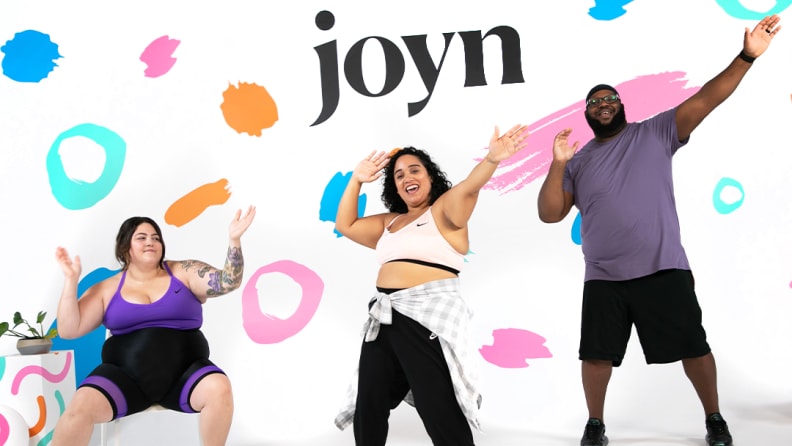I'm living with chronic pain—here's how I make exercise work
The best ways to move with a disability, according to experts.
Products are chosen independently by our editors. Purchases made through our links may earn us a commission.
I recently celebrated six years post-op of a back surgery that helped me walk again.
From August 2014 to March 2015, I had increasingly intense back pain. Nothing specific triggered it and I spent the last two months of that time in a wheelchair because the searing burning pain had spread throughout my body, especially in my left leg. It turns out I had several herniated discs in my lower back that were putting pressure on my spinal nerves and causing the pain. A Valentine’s Day MRI confirmed three herniated discs in the L5-S1 region of my back. A month later I had a microdiscectomy, a minimally invasive operation to remove a portion of the worst disc.
I still very much live with the pain. It dictates what I can and can’t do. I no longer have feeling in the back of my left leg and can’t really bend my toes, because my left leg was compromised from my herniated disc pushing on a nerve. My back flares up, mostly triggered by sharp sounds that cause vibration in the environment (when someone sneezes or taps their fingers on a desk, for example).
Since then I’ve made it my personal mission to help people find ways to navigate life in whatever way they need to—which, for me, includes working out. And because navigating pain is not a one-man journey, I teamed up with physical therapist Keith Foley and disability activist Claire Raymond for some insight on how to make exercise work with chronic pain.
Acknowledge the pain’s presence in your life and exercise routine
Before you even start exercising, acknowledge the pain. It’s here and plays a role in your life. And that role is totally natural, Foley tells me.
“One of the things I like to convey to my patients is that pain is a normal part of the human experience,” says Foley, who works at the Quincy, Massachusetts, branch of Joint Ventures Physical Therapy and Fitness. “It’s about our relationship with the pain, how we make sense of it that determines the outcomes. Understanding that hurt is not necessarily harmful in the moment can help you to not get stressed.”
I worked with a cognitive behavioral therapist back in 2019, and she did a great job of guiding me to make peace with the pain. My pain is a piece of me, one that dictates each physical step I take. If I ignore that part of me, I am doing just that—ignoring a part of me.
Recognizing that the pain exists continues into the actual workout. Every body operates differently, and exercises that help one person might not necessarily help another. Foley says he likes to hone in on the types of activities that each patient enjoys and then help them learn to manage those activities. “We know from research that exercise helps, but also it can be overwhelming to a lot of clinicians or even the person experiencing the pain. There’s a lot of options,” he says. “Consistency is the key. I like to figure out what that person likes to do and help them get back to it.”
Listen to your body when it tells you to stop
Part of working out is knowing when to stop. That’s just as important as starting, I’d argue—if not more so, especially when dealing with chronic pain. For me, this means knowing the difference between my standard level of pain, the kind I know that’s part of me, and the kind that tells me it’s time to stop.
Sometimes after much time in motion, I feel a familiar twinge in my lower back. A pinch. And I know my body is telling me, “That’s enough. It’s time to cool down, stretch, and stop.” I still have two herniated discs, though they’ve slipped back into place by now. I do not want to aggravate that. A few extra minutes may feel good in the immediate vicinity, but will make me miserable in the long run.
I learned this lesson the hard way. Last November, just days before my birthday, I did an intense running workout for seven days in a row. I did not take rest days. Something in me was curious about attaining a week-long running streak. And I paid for it the following morning when I threw my back out. That experience served as a wake-up call that overdoing it can be dangerous (and painful).
Working with your body, not against it, is vital, especially if you’re a fitness beginner, larger than many who fit the conventional fitness mold, or have disabilities or chronic pain. Now, I try to be mindful of my body’s abilities and be careful not to ignore those warning signs.
Disability advocate Claire Raymond works to make people aware of their bodies’ limitations. “Being mindful of your body is huge,” says Raymond, who has tethered cord syndrome, a condition in which scar tissue pulls on the spinal cord, causing nerve damage. Walking is extremely painful for her because of the lasting nerve damage to her spinal cord so she uses a wheelchair. “If something hurts, stop. Do not do that motion again.”
Work with your body’s capabilities
Alongside the limitations on the body, there are also a lot of capabilities. Raymond likes to dance, so she adapts that kind of movement to her body’s abilities. She chooses workout clothing made of comfortable stretchable material so that the fabric is not restricting on the pain medication pump in her abdomen. When she works out, she likes to use form-fitting outfits that do not risk getting caught in the wheel of her wheelchair. “When I’m sitting in my chair, I prefer longer shorts like a bike short because sweating when you’re in a wheelchair on your legs feels really gross. I like to have something to absorb that,” she says. “If you’re doing a heavy workout in a wheelchair, even putting a hand towel underneath your legs and butt can definitely help with that as well.”
Raymond likes Uniteable, an inclusive fashion line, for adaptive workout gear. She’s especially fond of the Hyacinth Pant, which features an anti-slip waistband that stretches up to three inches to stay in place throughout the day. Raymond appreciates the flexibility that this waistband provides during her workouts, especially because the pants were designed with wheelchair users in mind.
Comfortable clothing helps Raymond achieve the main goal of her workouts—moving around without causing extra pain or distractions. “From personal experience, I have had to find ways to move that don’t hurt,” she says. “When it comes to exercise, it should not be causing you significant pain.”
Like Raymond, Foley emphasizes the importance of listening to your body. He says that a patient can work with their medical team to best strategize a workout plan for their body.
“Having a long-term approach is important,” he says. “The uptake in pain during the day does not [always] mean that you are further damaging anything, it’s your body giving you a little bit of feedback: a certain time of day, a certain position. Work with your physical therapist and coach to come up with strategies to combat that.”
Modify any workouts based on your needs

Apps like Joyn may be helpful if you're looking for workouts with modifications.
As a child, I often did Leslie Sansone’s Walk Away the Pounds program with my mom. I remember Leslie saying something to the degree of “If you can’t do an exercise for whatever reason, modify it.” A woman named Beth would demonstrate the modified motion as the rest of the people in the video followed Leslie with the original motion.
That lesson always stuck with me. When I follow Kyra Pro, my fitness YouTuber of choice, I keep that six-letter word close in my heart: “modify.” It’s always possible, even if there isn’t a direct example in front of you. For example, Pro’s doesn’t explicitly offer modifications all the time but because I've taught my body how to modify, I can still follow along this baseline workout and simply change it as needed.
You may also want to search for beginner-friendly workouts on YouTube (you have options from yoga to cardio to bodyweight strength training), which offer options that move at a slower pace and are intended to be easier on the joints. There are also workout apps that make an effort to be inclusive, like Joyn, in which instructors often start with the modified exercise and level up as the class goes on, or Apple Fitness+, in which instructors always show modifications, too.
There is no shame in modifying tasks—in pain and in life. “We are so frequently taught to ‘push through pain,’ and with a chronic illness, everyday tasks can qualify as pushing through the pain,” Raymond says. When it comes to workouts, one size does not fit all, Foley says. "The biggest misconception is that there is a singular exercise or system of exercises that is going to ‘fix’ chronic low back pain," he says. "You need to look at not only the person, but their environment, their social support. When I treat persistent back pain, I try to look at the person as a whole. There's a lot of different factors that go into it besides the tissues and movement."
Use your resources—physical and otherwise

For me, a good mat and my walker go a long way.
Last November I had one of the oddest and most magical experiences of my life.
It was 5 a.m. and I had just thrown my back out a few days prior. All the same, I wanted to move. I shuffled over to my little workout room, put on my wireless headphones, and gripped the sides of my walker to steady myself as I prepared for a modified version of my usual running in place workout and dragged my feet from side to side.
It was a small broken iota of a workout, but it was something—and it made me happy. It was a combination of the early morning hour, the restlessness I wanted to combat, and the experience of listening to a new song from a musical I had just discovered. I needed the walker because I was hunched over and could not stand up straight or lean to the left. (I naturally lean to the right whenever I throw my back out.) And the pain was still there, oh very much so. But the walker made movement possible. Once I started moving, and kept moving, I realized “This is manageable.” I listened to the rest of the soundtrack from that musical and simply let myself move.
Even on days when my pain is at its standard, baseline level, there are some things I rely on for my workouts. I use a kids’ exercise mat for running in place, which I love because it gives me more space and support than a standard yoga mat. These five-pound weights from Target are soft to the touch and easy to grip, so they don’t put additional strain on my back when I shift from one position to another while holding them. Aesthetically, I find the gentle teal color attractive and cheerful. That little boost of happiness can make a difference no matter the pain level because it gives you a reason to smile. And on high pain days, or moments, or weeks, one reason to smile can be just enough.
Learn what works for you. That’s the essence of what working out (and doing everything else) with chronic pain boils down to.
Foley is a firm believer in education-based work to guide each patient’s unique experience with pain: a patient learning how their body works and about the resources available to them. “I try to shift people with chronic pain away from paths of modalities. I want them to learn how to listen and respond to the feedback,” he explains. “Different ways to help educate people. But also you can’t bombard them with it. It’s a balance, not a lecture.”
For his clients who work out at home, he recommends a comfortable yoga mat for exercise and stretching. “The more comfortable and enjoyable the environment is to perform the exercises and movements for your back, the more likely it is to be adhered to,” he says. Any mat you have and like should work—if you’re looking for a new one, we love the Lululemon Reversible 5mm mat, which has fantastic grip, so it prevents slipping even when you’re sweaty. For something cushier, we also like the Amazon Basics Extra Thick mat, which provides a great surface for exercises that require a softer surface.
To incorporate more movement into the day, Foley also recommends a sit-to-stand work desk (our favorite is the iMovr Lander desk), as well as a step stool such as the VIVO Adjustable Ergonomic Stool, especially with many people continuing to work from home due to COVID. “Variability is important for your spine, and the more options that you have to change your position throughout the day when working is very beneficial,” he says.
Of course, every patient’s toolbox will be different, and there will be days in which moving isn’t an option. “A big piece of advice is to make sure you clear certain exercises with a doctor, PT, or OT to make sure it will not worsen pain or conditions,” Claire Raymond advises.
Know you’re not alone
Navigating pain is a joint effort.
Each person’s case may be unique, but the phenomenon of pain is a shared one. And pain shared is pain halved. Read up on your pain, research message boards to hear testimonies from other patients. An increasingly connected world means that these resources are at our disposal. 80 percent of people will experience back pain at some point in their lifetime, according to the American Chiropractic Association. “80 percent of anything is normal,” Foley attests. “It’s trying to normalize it and de-threaten it. You will get past this.”
One minute I’ll be fine, the next minute a literal pin will drop and I’ll need to lie down immediately. It’s incredibly mentally taxing, on top of all of the physical pain.
Working out isn’t a one-size-fits-all deal. Going about your daily tasks isn’t a one-size-fits-all deal. It’s possible to create a fitness routine that works for you, with resources and medical insight, while being mindful of the pain’s existence and the limitations it places.“The thing I’ve learned is you’ve got to listen to the individual experience of dealing with the pain and be humble enough to recognize there’s many different ways of going about it,” Foley says. He encourages patients—and the doctors that treat them—to take the time to learn about the pain. “A big thing for providers is just to have that humility to listen to the person, sit with them, and help them understand,” he says.
The human body is resilient. The human mind is resilient. We will find a way to make it work.
The product experts at Reviewed have all your shopping needs covered. Follow Reviewed on Facebook, Twitter, and Instagram for the latest deals, product reviews, and more.


